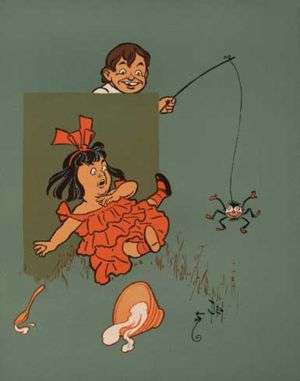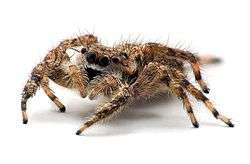Arachnophobia
| Arachnophobia | |
|---|---|
| Classification and external resources | |
| Specialty | Psychiatry |
| ICD-10 | 40.2 |
| ICD-9-CM | xxx |
Arachnophobia or arachnephobia[1] is a specific phobia, the fear of spiders and other arachnids such as scorpions.[2] The word is from Greek ἀράχνη (aráchnē), meaning "spider", and φόβος (phóbos), meaning "fear".
Signs and symptoms
People with arachnophobia tend to feel uneasy in any area they believe could harbor spiders or that has visible signs of their presence, such as webs. If arachnophobics see a spider, they may not enter the general vicinity until they have overcome the panic attack that is often associated with their phobia. Some people scream, cry, have emotional outbursts, experience trouble breathing, sweating or even heart palpitations when they come in contact with an area near spiders or their webs. In some extreme cases, even a picture or a realistic drawing of a spider can also trigger intense fear.
Reasons
Evolutionary
An evolutionary reason for the phobias remains unresolved. One view, especially held in evolutionary psychology, is that the presence of venomous spiders led to the evolution of a fear of spiders or made acquisition of a fear of spiders especially easy. Like all traits, there is variability in the intensity of fears of spiders, and those with more intense fears are classified as phobic. Spiders, for instance, being relatively small, do not fit the usual criterion for a threat in the animal kingdom where size is a factor, but they can be venomous.
By ensuring that their surroundings were free from spiders, arachnophobes would have had a reduced risk of being bitten in ancestral environments, giving them a slight advantage over non-arachnophobes in terms of survival. However, having a disproportional fear of spiders in comparison to the other, potentially dangerous creatures[3] that were present during Homo sapiens environment of evolutionary adaptiveness may have had drawbacks.
Arachnophobia may be an exaggerated form of an instinctive response that helped early humans to survive,[4] or a cultural phenomenon that is most common in predominantly European societies.[5]
Studies have shown that crickets can develop a fear of spiders before birth. Research also suggests the widespread fear of spiders may be innate in humans.[6]
Cultural

The alternative view is that the dangers, such as from spiders, are overrated and not sufficient to influence evolution. Instead, inheriting phobias would have restrictive and debilitating effects upon survival, rather than being an aid. For some communities such as in Papua New Guinea, Cambodia and South America (except Chile, Colombia, Costa Rica, Brazil, Uruguay, Argentina and Bolivia), spiders are included in traditional foods. This suggests arachnophobia may be a cultural, rather than genetic trait.[7][8]
Treatments
The fear of spiders can be treated by any of the general techniques suggested for specific phobias.
The first line of treatment is systematic desensitization – also known as exposure therapy – which was first described by South African psychiatrist Joseph Wolpe.[9] In addition, beta blockers, serotonin reuptake inhibitors and sedatives are used in the treatment of phobias.[10]
Before engaging in systematic desensitization it is common to train the individual with arachnophobia in relaxation techniques, which will help keep the patient calm. Systematic desensitization can be done in vivo (with live spiders) or by getting the individual to imagine situations involving spiders, then modelling interaction with spiders for the person affected and eventually interacting with real spiders. This technique can be effective in just one session.[11] The discovery of the implication of N-methyl-D-aspartate in fear and fear extinction[12] has led to the use of D-cycloserine—originally developed as an antibiotic—to augment the results of therapy.[13]
Recent advances in technology have enabled the use of virtual or augmented reality spiders for use in therapy. These techniques have proven to be effective.[14][15]
Epidemiology
Arachnophobia affects 3.5 to 6.1 percent of the population.[16]
See also
- Arachnophobia (film)
- Apiphobia (fear of bees)
- Entomophobia
- Myrmecophobia (fear of ants)
- Zoophobia
References
- ↑ Patricia Bowen (ed.), Internal Medicine Words, Rayve Productions, 1997, p. 18.
- ↑ Heather Hatfield. "The Fear Factor: Phobias". Webmd.com
- ↑ Gerdes, Antje B.M.; Uhl, Gabriele; Alpers, Georg W. (2009). "Spiders are special: fear and disgust evoked by pictures of arthropods" (PDF). Evolution and Human Behavior. 30: 66–73. doi:10.1016/j.evolhumbehav.2008.08.005.
- ↑ Friedenberg, J.; Silverman, G. (2005). Cognitive Science: An Introduction to the Study of Mind. SAGE. pp. 244–245. ISBN 1-4129-2568-1. Retrieved 2008-10-11.
- ↑ Davey, G.C.L. (1994). "The "Disgusting" Spider: The Role of Disease and Illness in the Perpetuation of Fear of Spiders". Society and Animals. 2 (1): 17–25. doi:10.1163/156853094X00045.
- ↑ "Fear of spiders can develop before birth". MSNBC. 2010-02-18. Retrieved 19 February 2010.
- ↑ Wagener, Alexandra L.; Zettle, Robert D. (2011). "Targeting Fear of Spiders With Control-, Acceptance-, and Information-Based Approaches" (PDF). The Psychological Record. 61 (1).
- ↑ Ohman, A; Mineka, S (2001). "Fears, Phobias, and Preparedness: Toward an Evolved Module of Fear and Fear Learning" (PDF). Psychological Review. 108 (3): 483–522. doi:10.1037/0033-295X.108.3.483. PMID 11488376.
- ↑ WOLPE, J (March 1961). "The systematic desensitization treatment of neuroses.". The Journal of Nervous and Mental Disease. 132: 189–203. doi:10.1097/00005053-196103000-00001. PMID 13786444.
- ↑ "Phobia Treatments and drugs". Mayo Clinic.
- ↑ Ost, L. G. (1989). "One-session treatment for specific phobias". Behaviour research and therapy. 27 (1): 1–7. doi:10.1016/0005-7967(89)90113-7. PMID 2914000.
- ↑ Davis, M (2011). "NMDA receptors and fear extinction: implications for cognitive behavioral therapy". Dialogues Clin Neurosci. 13 (4): 463–74. PMC 3263393
 . PMID 22275851.
. PMID 22275851. - ↑ Nave, AM; Tolin, DF; Stevens, MC (2012). "Exposure Therapy, d-Cycloserine, and Functional Magnetic Resonance Imaging in Patients With Snake Phobia: A Randomized Pilot Study". J Clin Psychiatry. 73 (9): 1179–1186. doi:10.4088/JCP.11m07564. PMID 23059145. Retrieved 2014-03-08.
- ↑ Bouchard, S.; Côté, S.; St-Jacques, J.; Robillard, G.; Renaud, P. (2006). "Effectiveness of virtual reality exposure in the treatment of arachnophobia using 3D games". Technology and Healthcare. 14 (1): 19–27.
- ↑ Kim, J., ed. (2011). Virtual Reality. InTech. ISBN 9789533075181.
- ↑ Schmitt, WJ; Müri, RM (2009). "Neurobiologie der Spinnenphobie". Schweizer Archiv für Neurologie. 160 (8): 352–355.
External links
- Stiemerling, D. (1973). "Analysis of a spider and monster phobia". Z Psychosom Med Psychoanal (in German). 1973 (4): 327–45. PMID 4129447.
- National Geographic: "Fear of Snakes, Spiders Rooted in Evolution, Study Finds"
